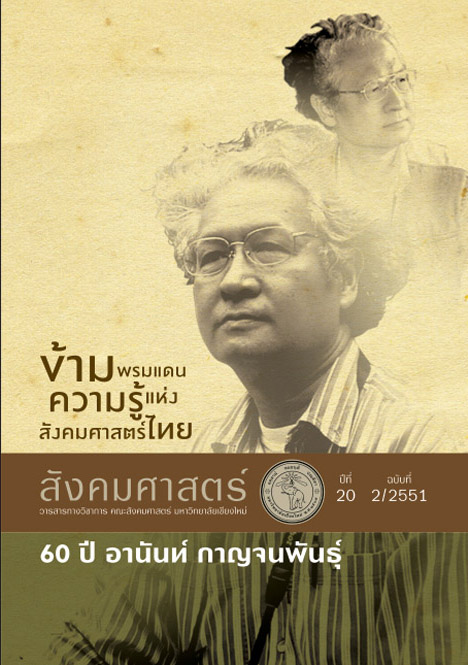From Colonial Capitalism to Frontier Capitalism: Rubber Plantations in Laos
Main Article Content
Abstract
This article traces the historical development of rubber plantations from the colonial time to the postcolonial Mekong era. It argues that the rise of rubber industry during the French administration was made possible by the system of colonial capitalism. However, current rubber expansion in southern Laos has been operating through the logic of frontier capitalism. For modern Lao state, rubber has become a magic plant that represents both art of government and tool of development believed to bring the country and its people out of poverty. Large-scale rubber plantations in Southern Laos have been made possible by the close tie between frontier states and transnational investors from Vietnam, and the weak regulating mechanism by the central state. Massive loss of land, involuntary de-peasantization, and vulnerable livelihood have thus characterized the contemporary political economy of Lao frontier.
Article Details
All written articles published on Journal of Social Sciences is its author’s opinion which is not belonged to Faculty of Social Sciences, Chiang Mai University or is not in a responsibility of the journal’s editorial committee’s members.
References
Cleary, Mark. 2003. “Land Codes and the State in French Cochinchina c. 1900-1940,” Journal of Historical Geography, 29:3, Pp.356-375.
Cleary, Mark and Peter Eaton. 1996. Tradition and Reform: Land Tenure and Rural Development in South-East Asia. Kuala Lumpur: Oxford University Press.
Curtin, Philip D.1990. The Rise and Fall of the Plantation Complex: Essays in Atlantic History. Cambridge University Press. Dean, Warren. Brazil and the Struggle for Rubber: A Study in Environmental History. Cambridge: Cambridge University Press, 1987.
Geertz, Clifford. 1968. Agricultural Involution: The Process of Ecologica Change in Indonesia. Berkeley: University of California Press.
Giusti-Cordero, Juan A. 1997. “Labour, Ecology, and History in a Puerto Rican Plantation Region: “Classic” Rural Proletarians Revisited”, Shahid Amin and Marcel van der Linden (eds.) Cambridge University Press.
Gordon, Alec. 2004 “Dynamics of Labour Transformation: Natural Rubber in Southeast Asia,” Journal of Contemporary Asia. Vol. 34, Iss. 4 (523-47).
International Rubber Study Group, Economic and Social Institute, Free University of Amsterdam (n.d.) The Futher of the Tyre and Rubber Sector
Firestone, Harvey Jr. The Romance and Drama of the Rubber Industry. Akron: Firestone Tire and Rubber Co., 1932.
Frank, Zephyr and Aldo Musacchio. “The International Natural Rubber Market, 1870-1930”. EH.Net Encyclopedia, edited by Robert Whaples. December 19, 2002. URL http://eh.net/encyclopedia/article/frank.international.rubber. market
Lang, Chris (1996) ‘The Legacy of Savage Development: Colonisation of Vietnam’s Central Highlands,” Watershed, 1(2) Nov.1995-Feb 1996.
Langcaster, Freda Jane. 1932. The Rubber Plantation Regions of Southeast Asia. Unpublished Thesis, University of Chicago.
Mintz, Sidney w. 1966. “The Caribbean as a Socio-Cultural Area”. In Cahiers d’Histoire Mondiale 9:912-937.
-------------- 1985 “From Plantations to Peasantries in the Caribbean”. In Caribbean Contours. Sidney W. Mintz and Sally Price, eds. Pp. 127-153. Baltimore: The Johns Hopkins University Press.
Murray, Martin. 1992. “‘White Gold’ or ‘White Blood?’: The Rubber Plantations of Colonial Indochina, 1910-40,” in Henry Bernstein,, E. Valentine Daniel, and Tom Brass. (eds.) Plantations, Peasants, and Proletarians in Colonial Asia. London : Cass.
Roberquain, Charles. 1944. The Economic Development of French Indo-China, (translated by Isabel A. Ward). London, New York: Oxford University Press.
Scolomb, Margaret. 2007. Colons and Coolies: The Development of Cambodia’s Rubber Plantations. Bangkok: White Lotus.
Schipani, Steven. 2007. “Ecotourism as an Alternative to Upland Rubber Cultivation in the Nam Ha National Protected Areas, Luang Namtha, Laos PDR. (http://www.nafri.org.la/05_news/workshops/rubber/papers/Sess3_p4_ecoshipani.2006.pdf )
Simone Vongkhamor, Khanchana Phimmasen, Bounnao Silapeth and Erik Petterson .2007.“Key Issues in Smallholder Rubber Planting in Oudomxay and Luang Prabang Provinces, Lao PDR,” Yoyoi Fujita (ed.), Upland Research and Capacity Development Programme, June.
Spire and Spire. 1906. Caoutchouc en Indochine: E’tude botanique, industrielle et commerciale (Paris: Augustin Challamel, ed. Libraire maritme et coloniale), Copy held in State Archive of Cambodia, Box 431.
Stoler, Ana Laura. 1985,1995. Capitalism and Confrontation in Sumatra’s Plantation Belt, 1870-1979. Ann Arbor: The University of Michigan Press.
Stuart-Fox, Martin. 1995. “The French in Laos 1887-1945,” Modern Asian Studies. 29:1, February, Pp.111-39.
Tate, D.J.M. 1996. The RGA History of the Plantation Industry in the Malay Peninsula, commissioned by The Rubber Growers’ Association (Malaysia) Berhad, Oxford, Kuala Lumpur: Oxford University Press.
Taussig, Michael. 1980. The Devil and Commodity Fetishism in South America. Chapel Hill: North Calorina University Press.
Tran Tu Binh. 1985. The Red Earth: A Vietnamese Memoir of Life on a Colonial Rubber Plantation. (Memoir), Ohio University Center for International Studies.
Tully, John. 2002. France on the Mekong: A History of the Protectorate in Cambodia, 1863-1953. Lanham, New York, Oxford: University Press of America.
Weinstein, Barbara. The Amazon Rubber Boom, 1850-1920. Stanford: Stanford University Press, 1983.
Wolf, Eric. 1959. “Specific Aspects of Plantations Systems in the New World: Community Sub-Cultures and Social Classes,” Plantation Systems of the New World. Ed. Vera Rubin. Washington, D.C.: Pan American Union.


